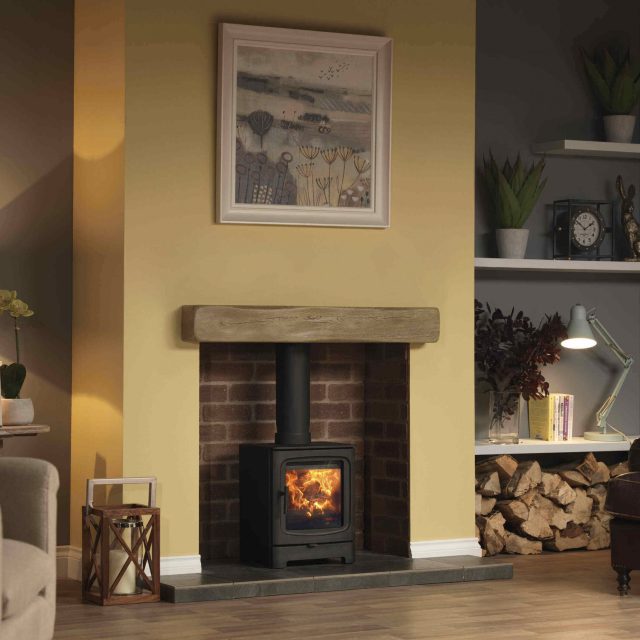Ready to use your wood-burning stove for the first time?
If you’re a complete beginner to solid-fuel stoves, there are a few things you may be unsure of. For example, you might be unsure of how to light it safely. You may even be wondering how to clean your stove to get the best results.
In this detailed how-to guide, we’ll take you through a step-by-step process of how to clean and light a wood-burning stove.
How to light a wood-burning stove
When you get a brand new stove, it might be tempting to immediately light a big fire, but you actually need to take a more gentle approach. If you’re wondering how to light a log burner safely and efficiently, then read on.
Here is our step-by-step guide for how to start a fire in a wood-burning stove:
- Gentle start: Metal can crack if heated up too rapidly, so avoid lighting a big fire initially to prevent damage to the stove. Instead, light a stove slowly and carefully, which we’ll explore more in the next stages.
- Gradual tempering: It’s important to gradually work your way up to a big fire. Light a small fire with wood a few times first, increasing the size each time and continue doing this over a few days to temper the stove. This approach should also be taken if your stove has been left unused for a while.
- Air vents: To start the fire, fully open both the primary (bottom) and secondary (top) air vents. Some stoves also have a third vent in order to include tertiary air for better combustion.
- Top-down method: In order to warm up the flue and ensure that smoke draws properly, follow the top-down method:
- Clean the stove and air holes
- Put larger logs at the bottom
- Put smaller logs or kindling in a grid pattern on top
- Add newspaper knots and firelighters
- Light the top and partially close the door, leaving it slightly ajar to allow airflow
- As the fire grows, you can then close the door completely
- Allow kindling to burn for 15-20 minutes
- Control the burn: Once you’ve closed the door, you can regulate the burn using the air vents as controls. Don’t close the vents completely as this can cause the fire to go out.
- Adding logs: To minimise smoke, wait until the first lot of logs have burned to become charcoal-like in appearance before you add any more. Open the air vents fully before you add more logs and wait for the air pressure to regulate before you open the door. When you do, it’s also wise to wear heat-proof gloves for your protection.
- Suitable wood: You can’t just add any wood to your stove. It has to have less than 20% water content, so if in doubt, use wood recommended by your stove manufacturer. As a general rule, opt for kiln-dried hardwood and avoid construction timber, treated wood or painted wood.
- Set up a stove fan: Consider placing an Enviro-Flame stove fan to help distribute the heat evenly around the room, enabling you to get the most heat output.
- Store smartly: Moisture can affect the quality of the wood, and so proper storage is essential. We offer Enviro-Flame moisture metres to check that your wood’s water content stays below 20%.
- Chimney syndrome: In spring and autumn time, chimney airflow can reverse, causing issues such as difficulty lighting the stove or smoke spilling out into the house. This is known as chimney syndrome. To sidestep this problem, use the top-down method or warm the chimney with a blowtorch for at least 15 minutes before using it.
Follow these above steps carefully to learn how to start a log burner as a beginner, or after a long hiatus.
How to light a wood-burning stove to stop smoke
It’s also important that you understand how to start a wood-burning stove to minimise produced smoke, helping keep your home healthy and smoke-free.
Just follow the below tips:
- Keep your stove clean and well-maintained, booking chimney sweeps at least once a year to prevent blockages.
- Avoid opening the stove door when the fire is in full flame, or adding more wood when it’s already full, instead wait for the wood to reduce down to coals before opening and refuelling.
- Use only dry wood that has a moisture content of less than 20%, as overly moist wood can produce more smoke.
- When opening the door, first open it slightly for around 20 seconds or so. This allows the airflow to adjust before you open all the way, also minimising the smoke produced.
- Warm up the flue or chimney before using in spring and autumn, or use the top-down method described in the above section.
Like anything that involves fire, your safety is a priority. Check out the next section to explore wood-burning stove safety tips.
Wood-burning stove safety
When lighting a wood-burning stove, you must put safety at the top of the list. To help you do this, here are our top tips for safe stove lighting.
- Get stove installation completed by a professional such as Enviro-Flame, as this ensures the most stringent safety standards are adhered to during fitting.
- Supervise children and animals to keep them away from a lit or hot stove.
- Keep flammable materials away from the stove and ensure it’s installed on a non-combustible surface.
- Ensure you have carbon monoxide alarms and smoke detectors in your home, and test them regularly.
- Wait for ashes to cool completely before clearing them from a stove, and keep the door closed while the ash is cooling down to prevent carbon monoxide buildup.
- Don’t leave buckets of ash inside your home, as this can cause carbon monoxide to build up if left for too long.
For more safety tips, check with your manufacturer or ask our team for more advice during installation.
How to clean a wood-burning stove
A key part of stove ownership is establishing a regular cleaning routine to keep the glass crystal clean, and to prevent build-up of ash and soot. A cleaning routine can be carried out weekly or fortnightly depending on how often you use the stove.
The main thing to remember when cleaning a wood-burning stove is to always follow your manufacturer’s manual, as they may have specific instructions that you need to follow.
However, for general instruction on how to clean a solid-fuel stove, follow the guidance below:
- Start clean: Ensure the stove is cold before you start cleaning.
- Sweep debris: Use a brush or vacuum to clean debris from the previous fires.
- Air circulation: Check and clear all circulation holes.
It’s now time to clean the glass to ensure your view of the crackling flames isn’t disturbed.
How to clean wood-burner glass
Next in our ‘how to clean a log burner’ guide, we’ll talk you through how to clean the glass.
The best method for this is to use an old piece of newspaper, dipping it in stove ash and using it to clean the inside of the glass. For the outside of the glass, use a glass cleaner.
Avoid using water on cast iron or steel to prevent rusting.
How to clean a wood-burning stove exterior
To finish off wood stove cleaning, turn your attention to the exterior. Wipe the outside with a dry and lint-free cloth. Remove any marks with a little WD40 or even some baby oil. Reinforcing the above point, do not use water on a cast iron or steel stove or it may develop rust.
You can also purchase specialist cleaners, but check with your manufacturer before using these.
How often should I get my chimney swept?
An annual chimney sweep is vital when you own a solid fuel stove. That’s because creosote, soot and other blockages can lead to chimney fires if they are left to build up without being cleared.
The team at Enviro-Flame provide full chimney inspections, CCTV flue surveys and chimney sweeping to ensure your chimney stays clean and healthy.
One chimney clean per year is recommended, though it is advisable to get it cleaned more often if you use a fireplace regularly. Consult with our specialists for further advice.
Keep your wood-burning stove in peak condition with chimney sweep services from Enviro-Flame. As a leading provider of stoves and fireplaces for Wimbledon and London, we also provide essential maintenance services for your solid fuel stove to ensure safety and complete functionality. To discover more, contact us today.




